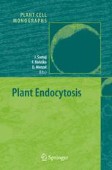Search
Search Results
-
Tethering proteins in membrane traffic
In eukaryotic cells, protein secretion and the transport of materials between membrane-bounded organelles require efficient and accurate delivery of...
-
Molecular mechanisms in clathrin-mediated membrane budding
Clathrin-coated vesicles (CCVs) form at the plasma membrane where they select cargo for endocytic entry into cells. CCVs also form at the trans-Golgi...
-
Metabolic flux analysis: A key methodology for systems biology of metabolism
Genome-wide analyses of mRNA, protein, or metabolite complements of biological systems produce unprecedented data sets. In contrast to such cellular...
-
Chaperone proteins and peroxisomal protein import
Peroxisomes are ubiquitous organelles present in most eukaryotic cells. Their role in cellular metabolism is diverse among species. An array of genes...
-
Systems biology of the yeast cell cycle engine
One goal of systems biology is to obtain an integrated understanding of the physiological properties of cells from the detailed molecular machinery...
-
Protein Kinases Involved in Mitotic Spindle Checkpoint Regulation
A number of checkpoint controls function to preserve the genome by restraining cell cycle progression until prerequisite events have been properly...
-
Regulation of exocytotic events by centrosome-analogous structures
Centrosomes, spindle pole bodies, and related structures, generally termed microtubule organising centres (MTOCs; Pickett-Heaps 1969), are best...
-
Ricin: structure, synthesis, and mode of action
Ricin is a lectin produced by the seeds of the Ricinus communis plant. It is potently toxic to mammalian cells, where it acts to inhibit the...
-
Role of the 5’-cap in the biogenesis of spliceosomal snRNPs
The biogenesis of spliceosomal UsnRNPs in higher eukaryotes involves a nucleocytoplasmic shuttling cycle. After transcription and processing in the...
-
Acidophilic structure and killing mechanism of the Pichia farinosa killer toxin SMKT
SMKT, a killer toxin produced by a halotolerant yeast Pichia farinosa that consists of α and β subunits, is generated from a chromosomally encoded...
-
Mechanisms and functions of RNA-guided RNA modification
RNA-guided 2’-O-methylations and pseudouridylations occur in several different types of RNAs and in a wide range of organisms. Hundreds of the RNAs...
-
Translational Recoding and RNA Modifications
During protein synthesis, codons in mRNA are translated sequentially in frame on the ribosome following strict decoding rules. This process is...
-
Modification and editing of RNA: historical overview and important facts to remember
RNA plays a central role in many cellular processes and several peculiarities of RNAs are probably relics of an ancient primordial RNA World. To...
-
Role of a conserved pseudouridine in U2 snRNA on the structural and electrostatic features of the spliceosomal pre-mRNA branch site
A pseudouridine (ψ) residue in a phylogenetically conserved position of U2 snRNA that pairs with the intron to form the pre-mRNA branch site helix of...
-
Um34 in selenocysteine tRNA is required for the expression of stress-related selenoproteins in mammals
Selenium is an essential micronutrient in the diet of mammals and has many health benefits. Selenium-containing proteins are responsible for most, if...
-
Zygocin – a monomeric protein toxin secreted by virus-infected Zygosaccharomyces bailii
Zygocin, a protein toxin secreted by virus-infected strains of the osmotolerant spoilage yeast Zygosaccharomyces bailii kills a broad spectrum of...
-
Modelling signalling pathways – a yeast approach
MAP kinase pathways are conserved signalling systems in eukaryotes that control stress responses, cell growth, and proliferation, as well as...
-
SNAREs in Plant Endocytosis and the Post-Golgi Traffic
In eukaryotic cells, the transport vesicles carry various cargo proteins from a donor compartment to a target compartment, and discharge the cargo...
-
Comparison of Molecular Mechanisms of Somatic and Zygotic Embryogenesis
Somatic embryogenesis has been used as a model system to understand the mechanisms regulating plant embryogenesis. The morphological and...
-
Extracellular Guidance Cues and Intracellular Signaling Pathways that Direct Pollen Tube Growth
Fertilization in flowering plants requires that a pollen tube deliver two sperm to the female gametes, which develop in ovules buried deep within...
